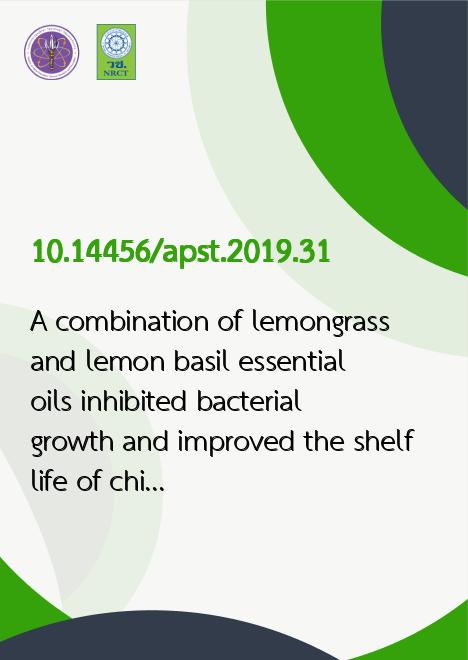
|
A combination of lemongrass and lemon basil essential oils inhibited bacterial growth and improved the shelf life of chicken fillets |
|---|---|
| รหัสดีโอไอ | |
| Creator | Alwani Hamad |
| Title | A combination of lemongrass and lemon basil essential oils inhibited bacterial growth and improved the shelf life of chicken fillets |
| Contributor | Alwani Hamad, Anggi Nuritasari, Dwi Hartanti |
| Publisher | Asia-Pacific Journal of Science and Technology |
| Publication Year | 2562 |
| Journal Title | Asia-Pacific Journal of Science and Technology |
| Journal Vol. | 24 |
| Journal No. | 4 |
| Page no. | 1-9 |
| Keyword | Essential oil, Cymbopogon citratus, Ocimumืafricanum, Preservation, Chicken fillet |
| URL Website | https://www.tci-thaijo.org/index.php/APST |
| Website title | https://www.tci-thaijo.org/index.php/APST/article/view/185151/158277 |
| ISSN | 2539-6293 |
| Abstract | Lemongrass [Cymbopogon citratus (DC.) Stapf] and lemon basil (Ocimumืafricanum Lour.) are spices commonly used in Indonesian culinary and both have been known for demonstrating antimicrobial properties. Hence, the combination of both plants has the potential to be developed further as a natural food preservative. In this study, the constituents of individual lemongrass and lemon basil essential oils were analyzed and their potential use as a natural preservative of chicken fillets was evaluated. The essential oils were obtained from a steam and water distillation process. The chemical constituents of both essential oils were analyzed by the Gas Chromatography-Mass Spectroscopy (GC-MS) technique. Their application as a preservative of chicken fillets was evaluated based on their capacity to inhibit the growth of bacteria on the meat as well as the physical observation of the preserved meat during 9 d of refrigerated storage. The combination of both essential oils at an optimal ratio of 1:1 %v/v was capable of significantly inhibiting the growth of bacteria on the meat during 9-d refrigerated storage as well as extending the shelf life of the meat for up to 6 d. The preservation effects shown by the combination of both essential oils might be due to the presence of the high proportion of oxygenated compounds that have been proven to be the antibacterial active compounds of essential oils, including geranyl acetate, geraniol, citronellal, estragole, and linalool. |